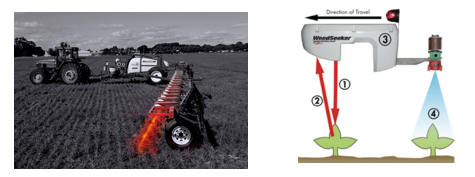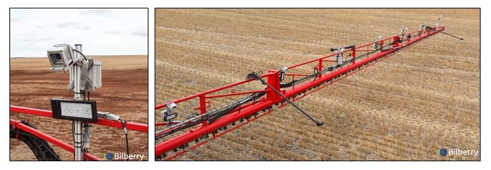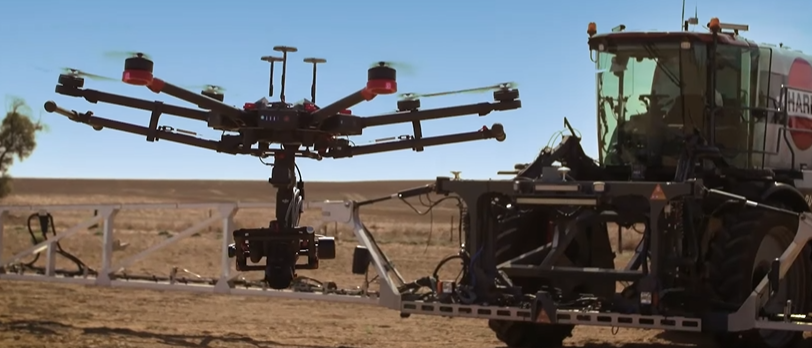Optical sprayers - management optimisation and field experience with their use on robotic platforms
Optical sprayers - management optimisation and field experience with their use on robotic platforms
Author: Jeremy Jones (Dalby Rural Supplies) | Date: 17 Nov 2021
Take home messages
Benefits of optical spraying:
- Control of hard to kill weeds – feathertop Rhodes grass, fleabane, milk thistle
- Chemical savings
- Chemical rotation
- Water use reduction
- Reduced seed set.
Common agronomic approach:
- Go early - You have the ability to economically target small weeds when they are easier to kill and before they have set seed. Don’t wait for the next germination, go now and come back for the next one
- Some growers have changed their approach to fallow spraying by spraying to a calendar instead of germination
- Go in hard with your chemical rates! – You are only spraying the weed so make sure you smoke it
- Mix up your chemistry – Optical sprayers enable the use of different (sometimes more expensive) products and still be economical. One of the best ways to combat resistance
- Be aware of mixing order and compatibility of chemistries - antagonism can occur if not mixed properly or if incompatible products are mixed.
Boom mounted sensor-based systems
Use NIR technology (WeedIT and WeedSeeker) to spot a weed in a fallow situation - Green on Brown (GoB).
 Figure 1. An example of a boom mounted sensor and a diagram showing how they work.
Figure 1. An example of a boom mounted sensor and a diagram showing how they work.
WEEDit Quadro
- Blue Beam of Quadro system is highest level of detection attainable
- Travel speeds of 20km/h with no loss of sensitivity
- No calibration required
- 25cm nozzle spacing – with PWM (pulse width modulation) functions
- 1m camera spacing – at 1100mm height
- Soon to release ISO connectivity and section control
- Utilises 40-03 and 40-04 nozzles.
WeedSeeker II
- WeedSeeker II was launched at Farmfest in June of 2019
- It has two great features which are ISO compatibility and section control
- Needs to calibrate once before use – may require additional calibration during operation
- Spacings have changed to 50cm instead of 38cm – Uses an 80-08 nozzle
- Uses an ‘on/off’ Goyen solenoid to release the spray
- Each sensor runs one nozzle.
Boom mounted green on green camera-based systems
Capture images and put them into an AI algorithm to identify the weed. The aim is to use both in crop and in fallow. Machine learning is involved. Detection of both Green-on-Brown (GoB) & Green-on-Green (GoG) becomes feasible with the one unit.
- Instead of a sensor looking for chlorophyll it uses a camera (RGB or hyperspectral) to take images and AI identifies the weed which is then sprayed. This is often achieved by angling the cameras forward to allow for processing time. This practice creates a large problem with shading
- Huge large amount of AI and machine learning required are delaying commercialisation, with early releases extremely specific to weed species and crop type
- Early releases are only operational during daylight hours
- Bilberry in conjunction with Agrifac and John Deere currently have just released systems for commercial sale
- Agronomic questions around which crops would have advantages to green-on-green spraying – should we be focusing on fallow weed control and use residuals pre plant? Which chemistries are available to achieve the desired results? Weeds must be visible above or in the crop canopy.
 Figure 2. An example of a boom mounted camera.
Figure 2. An example of a boom mounted camera.
Bilberry
- French based company that has partnered with Agrifac and Goldacres who supply the platform the system is mounted on. Have opened office in in Australia and has employees on the ground in WA because that is where the action is currently at
- Cameras mounted 3m apart across an Agrifac SP Sprayer, capable of widths up to 48m and an operational speed of 20km/hr.
- Huge issues with AI and machine learning – getting the computer to recognise a weed
- Currently GoB tech is commercially available but only for daylight use with external temperatures up to 30 degrees
- GoG is commercially available only on specific weeds in specific crops and does not cover all scenarios. e.g., wild radish in wheat is currently ready to go as well as blue lupins in lupins
- Works best at early crop stages where there is less interference from the crop
- Have not yet focused on East Coast weed issues (feathertop, fleabane, thistle)
- Being marketed via an algorithm subscription service on top of purchasing the technology.
Blue River Technologies
- John Deere purchased California based Blue River for approx. $300 million in late 2017
- Operates very similar to the Bilberry system with a different delivery method (very close / accurate solenoids) but the only sprayers sighted have been an inhouse build linkage unit using covers
- Appears to be very row crop focused – looking for weeds in cotton and vegetables (an easier proposition than looking for weeds in a broadacre crop).
John Deere See & Spray
- John Deere have released their own OSST called ‘See and Spray’ mounted to their self-propelled sprayers – only factory fitted system on the market
- Camera based RGB system looking for green on brown (no in crop use yet) using the Exact Apply PWM (pulse width modulation) system as the delivery method
- There are two user-selected modes. In ‘Single Nozzle’ Mode, the system turns on as few nozzles as possible. If the weed is directly under a nozzle, just that nozzle is turned on. Should the weed be in between two nozzles, both will be turned on. In ‘Overlapping’ Mode, a detection will turn on at least three and up to six adjacent nozzles. This mode is intended for herbicides that contain specific nozzle recommendations on the label
- Relies on ambient light conditions, recommended not be used within 30 minutes of dawn or dusk
- Tech has not come from Blue River but instead have partnered with USQ in Toowoomba this time around who did a lot of work in sugar cane
- GoG is being worked on (Blue River), but like Bilberry the computer learning is taking time to get right.
Xarvio Smart Sprayer
- Collaboration between Bosch, BASF and Amazone
- Combines Bosch's camera-based technology and software with Xarvio’ s (BASF) crop optimization platform on an Amazone sprayer claiming GoB AND GoG
- “During each pass with the SmartSprayer, the whole field is photographed using the Bosch camera system installed on the AMAZONE booms. The images are processed and real-time decisions regarding application are made. The SmartSprayer can be connected to the XarvioTM FIELD MANAGER, an agricultural decision platform that connects users, consultants and digital experts. The field use is based on a data memory without network connection”
- “The application rate per nozzle can be adjusted very quickly and easily using the PWFM application technology of the SmartSprayer, which has already been used in the UX AmaSpot”
- Again, it relies on a good AI platform – no detail of what weeds in what crops at this time.
AutoWeed
- Camera > AI based system, like Bilberry. GoG and GoB
- Australian based out of James Cook university in Nth QLD
- Currently focused on problem weeds in pasture, but testing in fallow cropping scenarios now
- Claims to be able to get the AI learning faster
- No commercial systems working yet but several ‘trials’ underway.
Greeneye Technology
- Israeli Competitor to Bilberry using a camera and AI to go green on brown and green on green
- Claims that field is scouted in sub-mm resolution – able to pick up disease as well as weeds
- Produces detailed scouting reports for further analysis on their own platform
- Launching in Nth America in 2022
Drone mounted camera / sensor based
Uses a drone fitted with a sensor or camera to create a map that is transferred to a sprayer for the job the be completed. Can use a camera AI system or sensor NDVI. (GoB & GoG)
- Uses a drone to fly the paddock and create a map which can then be used to drive a sectioned ground boom
- Drone is typically fitted with either a NVDI sensor (GoB) or a normal RGB camera (GoB & GoG) – the data is then fed into a software package and map produced, then put into the sprayer and applied
- Systems vary on the size of weed that can be targeted. Pixel density and the size of the picture (how much area is in frame) contribute to the ability to detect weeds. There is thus often a trade-off between altitude and cost. As an example, at a height of 80m Single Shot has an approximate ground sampling distance of 1cm, enabling it to accurately detect weeds of 3 to 4 cm (and smaller weeds with less accuracy) at coverage rates of in excess of 200 ha/ hr for an operating cost of ~$1.20 / ha.
- Time delays from flight time to spraying time. By way of example; processing of data from the Single Shot can be completed in the field provided internet connection is available (hotspot on phone is adequate), with spraying usually able to commence within 2 hours of completion of a flight. Processing time is usually quicker than flight time @ > 200 ha /hr.
- One other basic issue is that drones can only be operated in certain weather conditions and times of the day. Some systems are rated to fly under a wide range of wind conditions and different sensors respond more to changes in light conditions than others. Advice from suppliers on system flexibility under different wind and light conditions should be sought before deciding on a system purchase.
 Figure 3. An example of a drone mounted camera.
Figure 3. An example of a drone mounted camera.
InFarm
- Goondiwindi based start-up company pushing drone to sprayer tech
- The process uses a drone to capture high-definition images of the paddock. Images are then uploaded into a processing platform where a unique weed-identifying algorithm is applied
- A sprayer ready file can then be uploaded into a standard variable rate unit via a USB. The data then controls the nozzles and sections turning them on and off depending on the presence of weeds
- Drone is flown and map is processed by InFarm.
Hardi Geo Select
- Recently launched drone to sprayer tech using NDVI to identify weeds within a bare paddock (GoB). The drone records weed geo-location data which is put through the software and transferred to the sprayer
- Hardi has no direct dealing with the image capture process, but the program is only in their SP sprayers, trailing sprayer release in 2022
- As with any drone capture it is very weather dependent
- Sprayer currently operating 2 nozzles per section
- Reported as having tested Green on Green, but no release date at the time of writing.
References
Bilberry
https://bilberry.io/
https://agrifac.com.au/aicplus/technology-development
https://www.weedsmart.org.au/content/messina-family-mullewa-wa/
Blue River Technologies
http://www.bluerivertechnology.com/
https://youtu.be/XH-EFtTa6IU
John Deere See & Spray
https://sprayers101.com/see-spray-select/
https://www.youtube.com/watch?v=L0nGUSPDnUU
Xarvio Smart Sprayer
https://go.amazone.de/go2020/agritechnica/2019/neuheiten-en-us/pflanzenschutztechnik-en-us/smartsprayer-gemeinschaftsprojekt-en-us/
https://amazone.net/en/products-digital-solutions/agricultural-technology/crop-protection/amazone-ux-5201-smartsprayer-965618
AutoWeed
http://www.autoweed.com.au/
InFarm
https://www.infarm.io/
Hardi Geo Select
https://www.stockjournal.com.au/story/7346201/hardi-release-drone-led-selective-spraying-technology/
Single Shot
https://www.weedsmart.org.au/content/taking-a-single-shot-at-weeds/
Contact details
Jeremy Jones
Dalby Rural Supplies/Weedit
PO Box 1100, Dalby Qld 4405
Ph: 0458 626 101
Email: jeremy@dalbyruralsupplies.com.au
